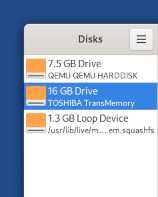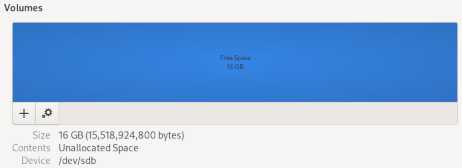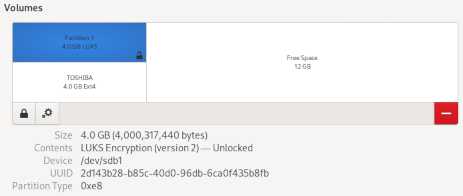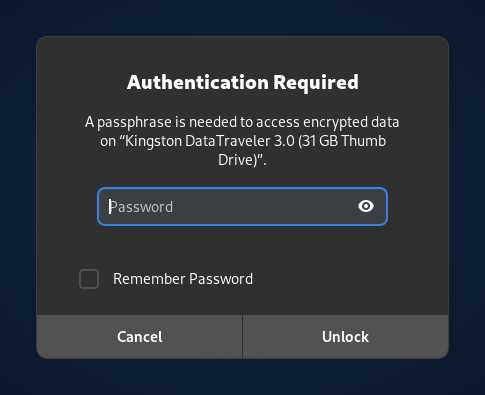- doc
- encryption and privacy
- Creating and using LUKS encrypted volumes
Introduzione a LUKS
The simplest way to carry around the documents that you want to use with Tails encrypted is to use the Persistent Storage.
Potete creare altri volumi criptati utilizzando LUKS per criptare, per esempio, un'altra chiavetta USB o un hard disk esterno. LUKS è lo standard per la crittografia dischi in Linux.
The Disks utility allows you to create encrypted volumes.
The GNOME desktop allows you to open encrypted volumes.
Confronto tra LUKS e VeraCrypt
Potete anche aprire volumi criptatiVeraCrypt all'interno di Tails. VeraCrypt è un tool per la crittografia del discorso per Windows, macOS e Linux. Guardate la nostra documentazione riguardo VeraCrypt.
We recommend that you use:
VeraCrypt to share encrypted files across different operating systems.
LUKS to encrypt files for Tails and Linux.
| LUKS | VeraCrypt | |
|---|---|---|
| Compatibility | Linux | Windows + macOS + Linux |
| Create new volumes | Yes | Outside of Tails |
| Open and modify existing volumes | Yes | Yes |
| Encrypted partitions (or entire disks) ¹ | Yes | Yes |
| Encrypted file containers ¹ | Complicated | Easy |
| Plausible deniability ² | No | Yes |
| Ease of use | Easier | More complicated |
| Speed | Faster | Slower |
Guardate la differenza tra contenitori di file e partizioni.
Negazione plausibile: In alcuni casi (per esempio con i volumi nascosti VeraCrypt), è impossibile per un avversario provare tecnicamente l'esistente di un volume criptato.
Still, deniable encryption might not protect you if you are forced to reveal the existence of the encrypted volume. See VeraCrypt: Plausible Deniability.
Creare una partizione criptata
Choose Applications ▸ Utilities ▸ Disks to open the Disks utility.
Identificate il vostro dispositivo di immagazzinamento esterno
The Disks utility lists all the current storage devices on the left side of the screen.
Selezionate il dispositivo di memoria esterna che intendete utilizzare.
A new device appears in the list of storage devices. Click on it.

Verificate che la descrizione del dispositivo sul lato destro dello schermo corrisponda al vostro dispositivo: la sua marca, le sue dimensioni ecc.
Formatting the device
Click on the
 button in the title bar and choose
Format Disk to erase all the existing partitions on the device.
button in the title bar and choose
Format Disk to erase all the existing partitions on the device.In the Format Disk dialog:
If you want to overwrite all data on the device, choose Overwrite existing data with zeroes in the Erase menu.
Overwriting existing data does not erase all data on flash memories, such as USB sticks and SSDs (Solid-State Drives).
See the limitations of file deletion.
Choose Compatible with all systems and devices (MBR/DOS) in the Partitioning menu.
Click Format.
In the confirmation dialog, make sure that the device is correct.
Click Format.
Creare una nuova partizione cifrata
Adesso lo schema delle partizione al centro dello schermo mostra un dispositivo vuoto:

Clicca sul bottone per creare una nuova partizione sul dispositivo.
Configure the various settings of your new partition in the partition creation assistant:
In the Create Partition screen:
Partition Size: you can create a partition on the whole device or only on part of it.
In the example below, we are creating a partition of 4.0 GB on a device of 8.1 GB.
In the Format Volume dialog:
Volume Name
You can give a name to the partition. This name remains invisible until the partition is open but can help you to identify it during use.
Erase
You can choose to overwrite existing data on the partition.
Overwriting existing data does not erase all data on flash memories, such as USB sticks and SSDs (Solid-State Drives).
See the limitations of file deletion.
Type
Choose Internal disk for use with Linux systems only (Ext4) and Password protect volume (LUKS).
In the Set Password screen:
Password: type a passphrase for the encrypted partition and repeat it to confirm.
We recommend choosing a long passphrase made of 5 to 7 random words. Learn about the maths behind memorizable and secure passphrases.
It is impossible to recover your passphrase if you forget it!
To help you remember your passphrase, you can write it on a piece of paper, store it in your wallet for a few days, and destroy it once you know it well.
Dopo clicca Creare.
La creazione della partizione potrebbe richiedere da pochi secondi ad alcuni minuti. Dopodiché la nuova partizione cifrata apparirà nei volumi sul dispositivo:

Se volete creare un'altra partizione nello spazio libero sul dispositivo, cliccate sullo spazio libero e cliccate nuovamente sul bottone .
Usare la nuova partizione
Potete aprire questa nuova partizione dalla barra laterale del file browser con il nome che le avete dato.
Dopo aver aperto la partizione con il file browser potrete accedervi anche dal menù .
Aprire una partizione cifrata esistente
When you plug in a device that has an encrypted partition, Tails offers to unlock the encryption automatically.
Plug in the external storage device that has the encrypted partition.
A dialog appears, asking for the passphrase to unlock the partition.

Enter the passphrase of the partition in the password prompt and click Unlock.
If you turn on the option Remember Password, Tails remembers the passphrase of this partition only until you shut down. The passphrase is not stored in your Persistent Storage.
After unlocking, you can access the content of the partition from either:
- The Places menu
- The sidebar of the Files browser
After you finished using the partition, click on the ![]() button next to the partition in the
sidebar of the Files browser to eject the partition safety and lock again the
encryption.
button next to the partition in the
sidebar of the Files browser to eject the partition safety and lock again the
encryption.
Archiviare documenti sensibili
Tali dispositivi cifrati non sono nascosti. Un attaccante in possesso del dispositivo può sapere che all'interno c'è un volume cifrato. Prendete in considerazione che potreste essere ingannati o costretti a fornire la frase d'accesso.
Aprire volumi cifrati da altri sistemi operativi
E' possibile aprire questi volumi cifrati da altri sistemi operativi; tuttavia, facendolo potresti compromettere la sicurezza fornita da Tails.
Per esempio, l'altro sistema operativo potrebbe creare e salvare provini delle immagini. Oppure, il contenuto dei file potrebbe venire indicizzato dall'altro sistema operativo.
Cambiare la frase d'accesso di una partizione cifrata esistente
Choose Applications ▸ Utilities ▸ Disks to open the Disks utility.
Plug in the external storage device that contains the encrypted partition for which you want to change the passphrase.
The device appears in the list of storage devices. Click on it.

Verificate che la descrizione del dispositivo sul lato destro dello schermo corrisponda al vostro dispositivo: la sua marca, le sue dimensioni ecc...
Click on the partition displaying a
 in the bottom-right corner.
in the bottom-right corner.Click on the
 button and choose Change Passphrase in
the shortcut menu.
button and choose Change Passphrase in
the shortcut menu.
